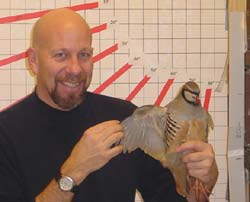New Study Suggests Missing Link that Explains How Dinosaurs Learned to Fly

Ken Dial, who is a professor of vertebrate morphology and a licensed commercial pilot, holds an adult chukar partridge in his flight lab at the University of Montana. <br>Photo Credit: K.P. Dial, University of Montana <br>
Two-legged dinosaurs may have used their forelimbs as wing-like structures to propel themselves rapidly up steep inclines long before they took to the skies, reports a University of Montana researcher in the January 17 issue of the journal Science. The new theory adds a middle step that may link two current and opposing explanations for how reptiles evolved into flying birds.
According to Kenneth Dial, author of the report, the transition from ground travel to flight may have required a “ramp-up” phase in which rapid movement of the animals’ front appendages actually forced its body downward to gain more foot traction as it made its way up increasingly vertical slopes.
“The big dilemma has been, ’How do you explain the partial wing?,’” says Dial, who is a professor of vertebrate morphology and ecology. “It turns out the proto-wings-precursors to wings birds have today-actually acted more like a spoiler on the back of a race car to keep the animal sure-footed even while climbing up nearly vertical surfaces,” he said.
“The development and role of movement in animals is critical to every aspect of their lives,” says William Zamer of the National Science Foundation (NSF), the agency that funded the study. “The results may also one day help humans design better vehicles for both land and air travel.”
NSF is an independent federal agency that supports fundamental research and education in all fields of science and engineering.
The evolution of flying vertebrates has been a bone of contention since the 1800’s. One school, which embraced the cursorial theory, argued that two-legged, ground-dwelling animals developed feathered wings that allowed them to become airborne. The opposing school, which favored the arboreal theory, held that flight originated in tree-dwelling animals that leapt from limb to limb and eventually developed gliding structures to soften their landings. For a century-and-a-half, each camp has tendered evidence to challenge the opposing theory.
The solution, Dial says, may lie in an ordinary flapping behavior, which he calls “wing-assisted incline running,” or WAIR, found in many modern-day hatchling and adult birds. “Although this behavior is common in nature, ” he writes, WAIR’s role in the evolution and survival of birds “has remained unappreciated” because it happens in short bursts that are difficult to study in the wild.
So, Dial, who is also a licensed commercial an instrument-rated pilot, applied to partridges devices that sensed g-force and used high-speed film to document wing orientation in a laboratory setting. He found that newly hatched birds, yet unable to fly, successfully used WAIR to climb a 50-degree incline. Slightly older birds used WAIR to climb a 90-degree, or straight-up, surface, and adult birds used their wings literally to defy gravity. Wing flapping kept their bodies secured to the underside surface of a 105-degree overhang.
“A significant portion of the wing beat cycle involves…forces that push the bird toward the inclined substrate, permitting animals to run vertically,” Dial observed.
Dial proposes that WAIR in modern-day birds is a remnant of their prehistoric ancestors. “In the proto-bird, this behavior would have represented the intermediate stage in the development of flight-capable, aerodynamic wings.” Further re-orientation of the wings could then allow birds to make successful ascents into the air as well as safe landings.
Experts believe birds evolved from a common ancestral protoavis dinosaur some 225 million years ago during the Mesozoic era. As the continental land mass broke apart, birds inhabited all corners of the Earth. While most bird species were wiped out with the dinosaurs 65 million years ago, many scientists consider birds the only true living relative of the dinosaurs.
-NSF-
NSF is an independent federal agency that supports fundamental research and education across all fields of science and engineering, with an annual budget of nearly $5 billion. NSF funds reach all 50 states through grants to nearly 2,000 universities and institutions. Each year, NSF receives about 30,000 competitive requests for funding, and makes about 10,000 new funding awards. NSF also awards over $200 million in professional and service contracts yearly.
Receive official NSF news electronically through the e-mail delivery system, NSFnews. To subscribe, send an e-mail message to join-nsfnews@lists.nsf.gov. In the body of the message, type “subscribe nsfnews” and then type your name. (Ex.: “subscribe nsfnews John Smith”)
Media Contact
All latest news from the category: Life Sciences and Chemistry
Articles and reports from the Life Sciences and chemistry area deal with applied and basic research into modern biology, chemistry and human medicine.
Valuable information can be found on a range of life sciences fields including bacteriology, biochemistry, bionics, bioinformatics, biophysics, biotechnology, genetics, geobotany, human biology, marine biology, microbiology, molecular biology, cellular biology, zoology, bioinorganic chemistry, microchemistry and environmental chemistry.
Newest articles

Durable, Efficient, Sustainable: The Rise of Cerium Oxide Thermal Switches
Groundbreaking cerium oxide-based thermal switches achieve remarkable performance, transforming heat flow control with sustainable and efficient technology. Cerium Oxide-Based Thermal Switches Revolutionize Heat Flow Control Thermal switches, which electrically control…

How Industrial Robots are Reducing Emissions in Global Manufacturing
A new study explores the intersection of industrial automation and environmental sustainability, focusing on the role of industrial robots in reducing the carbon intensity of manufacturing exports. The research demonstrates…

Patients Can Heal Through Precise, Personalized Bioceramic Grafts
A recent review is transforming the landscape of craniomaxillofacial bone regeneration with the introduction of personalized bioceramic grafts. This pioneering research explores the fabrication and clinical potential of synthetic grafts…



